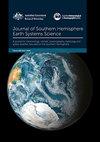Biases and teleconnections in the Met Office Global Coupled Model version 5.0 (GC5) – insights for seasonal prediction and Australia
IF 3.6
4区 地球科学
Q1 Earth and Planetary Sciences
引用次数: 0
Abstract
The Australian Bureau of Meteorology (The Bureau) has been involved in the package testing and assessment process of the UK Met Office Global Coupled Model Version 5.0 (GC5) configuration. GC5 will underpin the Met Office’s next seasonal prediction system, global coupled numerical weather prediction (NWP) system and Earth System Model. It will also likely be the next version of The Bureau’s seasonal prediction system, and the version to replace the global atmosphere-only NWP system to be the first global coupled NWP system at The Bureau. The GC5 configuration includes a new sea-ice model and substantial updates to almost all areas of model physics. We have evaluated the present-day climate simulation, and compared it to observations and with previous versions GC4 and GC2. Our assessment focuses on the climate mean state and variabilities relevant to Australian seasonal prediction, including the El Niño–Southern Oscillation (ENSO), the Indian Ocean Dipole (IOD), the Southern Annular Mode and the Madden–Julian Oscillation. Notably, in comparison to its predecessor (GC4), GC5 shows significant improvements in the eastern Pacific mean state but a slight degradation in the Indian Ocean in terms of the mean state and variability. These and other results provide us with early insights of the potential performance of the next sub-seasonal or seasonal forecast system. Longstanding issues in the seasonal prediction system associated with the equatorial eastern Indian Ocean biases and an overactive ENSO and IOD will likely remain; however, improvements over the eastern equatorial Pacific in GC5 hold promise of improved prediction skill of ENSO and its teleconnections.英国气象局全球耦合模式5.0版(GC5)中的偏差和遥相关——对季节预测和澳大利亚的见解
澳大利亚气象局(The Bureau of Meteorology)已经参与了英国气象局全球耦合模型5.0版(GC5)配置的测试和评估过程。GC5将支持英国气象局的下一个季节预报系统,全球耦合数值天气预报(NWP)系统和地球系统模型。它也很可能是美国气象局的下一个季节预报系统,并将取代仅用于全球大气的NWP系统,成为该局的第一个全球耦合NWP系统。GC5配置包括一个新的海冰模型和对模型物理几乎所有领域的实质性更新。我们已经评估了当前的气候模拟,并将其与观测结果以及以前的版本GC4和GC2进行了比较。我们的评估重点是与澳大利亚季节预测相关的气候平均状态和变率,包括厄尔Niño-Southern涛动(ENSO)、印度洋偶极子(IOD)、南环模和马登-朱利安涛动。值得注意的是,与它的前身(GC4)相比,GC5在东太平洋的平均状态有显著改善,但在印度洋的平均状态和变率方面略有下降。这些和其他结果为我们提供了下一个分季节或季节预报系统潜在性能的早期见解。与赤道东印度洋偏倚和过度活跃的ENSO和IOD有关的季节预测系统中长期存在的问题可能会继续存在;然而,GC5期间赤道东太平洋的改善有望提高ENSO及其遥相关的预测技能。
本文章由计算机程序翻译,如有差异,请以英文原文为准。
求助全文
约1分钟内获得全文
求助全文
来源期刊

Journal of Southern Hemisphere Earth Systems Science
Earth and Planetary Sciences-Oceanography
CiteScore
8.10
自引率
8.30%
发文量
0
审稿时长
>12 weeks
期刊介绍:
The Journal of Southern Hemisphere Earth Systems Science (JSHESS) publishes broad areas of research with a distinct emphasis on the Southern Hemisphere. The scope of the Journal encompasses the study of the mean state, variability and change of the atmosphere, oceans, and land surface, including the cryosphere, from hemispheric to regional scales.
general circulation of the atmosphere and oceans,
climate change and variability ,
climate impacts,
climate modelling ,
past change in the climate system including palaeoclimate variability,
atmospheric dynamics,
synoptic meteorology,
mesoscale meteorology and severe weather,
tropical meteorology,
observation systems,
remote sensing of atmospheric, oceanic and land surface processes,
weather, climate and ocean prediction,
atmospheric and oceanic composition and chemistry,
physical oceanography,
air‐sea interactions,
coastal zone processes,
hydrology,
cryosphere‐atmosphere interactions,
land surface‐atmosphere interactions,
space weather, including impacts and mitigation on technology,
ionospheric, magnetospheric, auroral and space physics,
data assimilation applied to the above subject areas .
Authors are encouraged to contact the Editor for specific advice on whether the subject matter of a proposed submission is appropriate for the Journal of Southern Hemisphere Earth Systems Science.
 求助内容:
求助内容: 应助结果提醒方式:
应助结果提醒方式:


